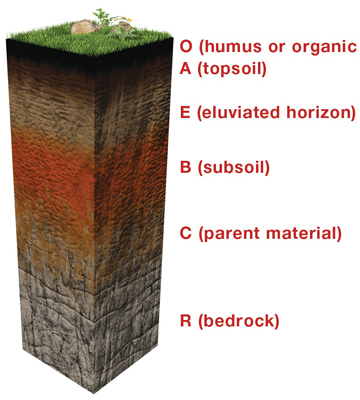Easy Questions About What Lives in Soil for Kids
What is Soil?
Soils are complex mixtures of minerals, water, air, organic matter, and countless organisms that are the decaying remains of once-living things. It forms at the surface of land – it is the "skin of the earth." Soil is capable of supporting plant life and is vital to life on earth.
Soil, as formally defined in the Soil Science Society of America Glossary of Soil Science Terms, is:
- The unconsolidated mineral or organic material on the immediate surface of the earth that serves as a natural medium for the growth of land plants.
- The unconsolidated mineral or organic matter on the surface of the earth that has been subjected to and shows effects of genetic and environmental factors of: climate (including water and temperature effects), and macro- and microorganisms, conditioned by relief, acting on parent material over a period of time.
So then, what is dirt? Dirt is what gets on our clothes or under our fingernails. It is soil that is out of place in our world – whether tracked inside by shoes or on our clothes. Dirt is also soil that has lost the characteristics that give it the ability to support life – it is "dead."
Soil performs many critical functions in almost any ecosystem (whether a farm, forest, prairie, marsh, or suburban watershed). There are seven general roles that soils play:
- Soils serve as media for growth of all kinds of plants.
- Soils modify the atmosphere by emitting and absorbing gases (carbon dioxide, methane, water vapor, and the like) and dust.
- Soils provide habitat for animals that live in the soil (such as groundhogs and mice) to organisms (such as bacteria and fungi), that account for most of the living things on Earth.
- Soils absorb, hold, release, alter, and purify most of the water in terrestrial systems.
- Soils process recycled nutrients, including carbon, so that living things can use them over and over again.
- Soils serve as engineering media for construction of foundations, roadbeds, dams and buildings, and preserve or destroy artifacts of human endeavors.
- Soils act as a living filter to clean water before it moves into an aquifer.
Soil Profile
There are different types of soil, each with its own set of characteristics. Dig down deep into any soil, and you'll see that it is made of layers, or horizons (O, A, E, B, C, R). Put the horizons together, and they form a soil profile. Like a biography, each profile tells a story about the life of a soil. Most soils have three major horizons (A, B, C) and some have an organic horizon (O).
The horizons are:
O – (humus or organic) Mostly organic matter such as decomposing leaves. The O horizon is thin in some soils, thick in others, and not present at all in others.
A - (topsoil) Mostly minerals from parent material with organic matter incorporated. A good material for plants and other organisms to live.
E – (eluviated) Leached of clay, minerals, and organic matter, leaving a concentration of sand and silt particles of quartz or other resistant materials – missing in some soils but often found in older soils and forest soils.
B – (subsoil) Rich in minerals that leached (moved down) from the A or E horizons and accumulated here.
C – (parent material) The deposit at Earth's surface from which the soil developed.
R – (bedrock) A mass of rock such as granite, basalt, quartzite, limestone or sandstone that forms the parent material for some soils – if the bedrock is close enough to the surface to weather. This is not soil and is located under the C horizon.
Source: https://www.soils4kids.org/about
Post a Comment for "Easy Questions About What Lives in Soil for Kids"